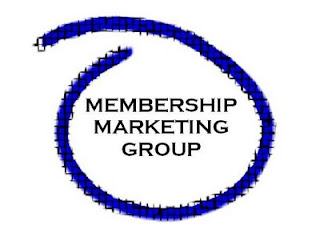You can click on the picture to get a larger view.

Membership marketing – acquiring, engaging, upgrading, and renewing members – is the cornerstone for associations and relationship driven organizations. Whether you are an association professional or a relationship marketer, join the discussion on the Membership Marketing Blog and share your ideas and counsel.


Friends of this blog, Maddie Grant and Lindy Dreyer, have put together several seminars on social networking that they are making available. They look really good. You can contact them directly to find out more at: Social Fish.
Here are a couple of the upcoming topics that are available.
Introduction to Personal Blogging (101 level)
Introduction to Association Blogging (101 level)
Getting Started on Twitter (101 level)
Learn how to sign up, how to follow the most relevant people, what is Twitter etiquette, how to use Twitter Search, and some of the different applications to choose from for viewing your Twitter stream online or on the go.
By the way, I am on Twitter now. You can connect to me at with this link.


With gas prices up and down, we are hearing a lot these days about supply and demand. So I was thinking, how does supply and demand play out with membership marketing?
Here are three observations.
What implications does this have for your 2009 planning?
Let me know if you agree with these observations.

If you are a member of ASAE and the Center for Association Leadership, you are eligible to participate in their social networking site. This is a place where you can post questions, engage in conversations, and connect to other like minded professionals.
Today, I set up a group on the site for Membership Marketing. If you would like to give it a try, I am including instructions here on how to register.
Here is the initial discussion question that I have posted for the group:
How is the current economic slowdown impacting your membership? Are fewer members joining and renewing? Or are people flocking to your association for safety and help in finding jobs, customers, and information? Please share your experiences.
Please feel free to give the site a try.
I encounter the first two problems regularly. As far as data integration, some organizations would benefit by appending third party data to their members and prospects, but have trouble adding this information to their CRM system. Some also end up maintaining multiple specialized databases in the organizations, but the knowledge is not linked from one to the other.
Data integrity is also a common challenge. Issues like entering marketing codes, keeping contact information up to date -- especially for former members, and consistent data standards are ongoing problems.
How have we dealt with this challenge? For the most part, we have found it necessary to extract data from clients’ databases in order to do clean up and analysis. The longer term solution may be to build data marts with the focus of gathering member and prospect behavior and slicing and dicing this into real marketing intelligence.
What do you think is the solution?

Many traditional surveys evaluate member satisfaction with an organization. But does satisfaction give a clear picture of what members really feel and want?
We wanted to find out! So in a recent membership survey, we asked both satisfaction and loyalty questions. These questions measure members’ feelings about the organization, their likelihood to renew membership and their willingness to recommend membership to others.
The findings comparing these two techniques were enlightening.
The good news is that we found that membership satisfaction ran at 90.8%.
However, we saw a much more diverse picture using our loyalty questions. Based on these questions we found:
By measuring loyalty instead of satisfaction with this organization, a membership picture comes into focus that lends itself to action. This is especially true as each loyalty category is cross tabulated by job titles, membership tenure, company type, and other key demographics.
Do you have a meaningful measure of membership loyalty for your organization?

Feel free to add any tips you have in the comments section. Also, I am curious to hear what you have seen done poorly at trade shows. We could come up with a top 10 list of what not to do.




I wanted to share a story today that my friend Chris Bluhm, Chief Operating Officer, of The American Occupational Therapy Association (AOTA) gave me permission to share with you.
Over the past several years, Chris and his colleagues have established the AOTA National Partnership Program. As part of the benefits, the program includes a block of memberships that the partner company provides to their staff. This results in instant company paid memberships for AOTA. However, the partners also greatly benefit from the program as tool to help them identify, recruit, and retain top occupational therapists.
Two companies, Genesis Rehab Services and RehabCare have joined the program so far. The most recent partnership will allow RehabCare’s almost 1,300 occupational therapy practitioners to have access to the educational and professional resources that AOTA offers to other members. The 1,300 members also represent a sizeable new member input for AOTA.
There are a couple of reasons why I wanted to share this story. First, because it is an example of very smart membership marketing and that is what this blog is all about. There are multiple ways to grow membership for an organization and it is wise to take advantage of each opportunity. Obviously, this all assumes that a sound financial rational has been put in place before initiating any agreements.
My second reason is that there can be a fear among non-profits of partnering with for profit companies. Just yesterday, I saw members of an association list serv cautioning against allowing for profits to buy membership and give them to customers because it might lower the perceived value of the association or result in higher non-renewals.
Here are some reasons why I like the idea of developing innovative forms of bulk membership offers like the National Partnership Program.
Let me know if you agree or disagree with me on these points. Have you had any bulk membership or partnership experiences with membership? Please share them.



Perhaps the single biggest challenge with global membership marketing is the language barrier. There are 256 languages in the world with over 1,000,000 speakers[1].
On top of the variety of languages there are also dialects and variations associated with many languages. A visiting French exchange student just this weekend told me that he had a very difficult time understanding the French spoken in Quebec.
So how does an organization move forward in this area? One tact that successful organizations have followed is to get started with the language in which member benefits are now provided.
In order to start global membership marketing, one group that I work with decided to reach out to countries with high proportions of primary and secondary English speakers like Australia, Canada, England, Hong Kong, Ireland, New Zealand, and Singapore.
To date, using American English, the promotions have generated very positive response rates and very few complaints.
The basic language philosophy is to market using the same language and dialect in which the actual membership product will be delivered. If a recipient struggles with the American English marketing materials, then they will not be very likely to be able to use the membership materials.
Reaching English speakers across the globe actually presents a fairly large market opportunity. For example, more people speak English in India, Nigeria, Germany, or the Philippines than in Canada.[2]
Another organization that has relied primarily on English is Toastmasters. Toastmasters “now have nearly 226,000 members in 11,500 clubs in 92 countries.” However, they do not support the translation of their materials until a large enough membership base has developed in a language group. The translation policy is clearly outlined in their organizations procedures.[3]
What do you think is the right approach to language in global membership marketing? Language issues can elicit very emotional and heartfelt reactions. I am curious how you deal with these challenges.
[1] http://en.wikipedia.org/wiki/List_of_languages_by_number_of_native_speakers
[2] http://en.wikipedia.org/wiki/List_of_countries_by_English-speaking_population
[3] http://www.toastmasters.org/websiteApps/policyProcedures/SectionVIA6.pdf
But probably the most cost effective and timely method for most organizations trying to serve global members is to use one of the mailing methods above through an international mail consolidator available under the USPS Postal Qualified Wholesaler program. These companies receive additional postal discounts from the USPS and will also:
My production manager tells me that in a recent mailing he did to the Pacific Rim of 26,000 pieces of mail, the postage savings of using an international mail consolidator ran around $8000 in comparison to mailing independently. Here is the link to a list of companies serving as a Postal Qualified Wholesaler.
How is your organization acquiring and serving global members?



Here is my thought, what bigger questions are there to consider than some of the following issues:
I have some ideas on a number of these issues. But as I have been asked questions lately by my very inquisitive daughter, I have come to see that I do not know as much as I think I do.
So it is back to the books: A look at some of the deeper questions about life.
What will you be reading this summer?
 In addition to adding new members through acquisition efforts, the new renewal system has helped the retention rate increase by an impressive 7 points.
In addition to adding new members through acquisition efforts, the new renewal system has helped the retention rate increase by an impressive 7 points.



